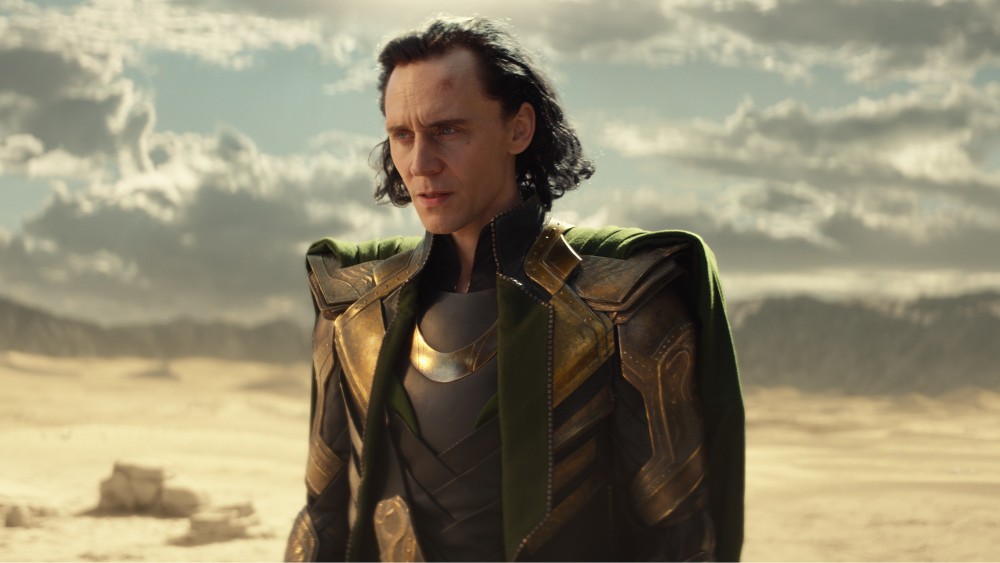
The Disney+ and Marvel Studios series Loki focuses on Tom Hiddleston’s prankster god, who was introduced all the way back in 2011’s Thor. Instead of being about Asgard and Loki’s relationship with his hammer-wielding brother, the show instead focuses on Loki being tried for his crimes… against time.
Season 1 of Loki consisted of just six episodes, but it makes the most of each one, as we meet the TVA (Time Variant Authority) and one of its lead investigators, Mobius (Owen Wilson), and we actually learn how the God of Mischief’s many misdeeds have led to the creation of many Loki variants. One of those is Sylvie (Sophia Di Martino), a rogue Loki who has run rampant across time. The TVA needs Loki’s help to catch her, and along the way, we meet other Lokis, including one played by Oscar nominee Richard E. Grant, as well as an Alligator Loki.
Coming up with a new look for Hiddleston’s Loki was only the tip of the iceberg for Costume Designer Christine Wada, who had to create outfits for Mobius, Sylvie, and the entire TVA, as well as a whole lot of different Lokis — except for the alligator, of course. Wada is a longtime industry pro who has worked in high-profile costume departments since the mid-’90s, with credits on many Coen Brothers movies as well as the comedy Bridesmaids.
A few weeks back, Below the Line had a chance to speak with Wada over the phone about her Emmy-nominated work on the show. Read our chat below to learn a lot more about her as well as her influences and inspirations, which weren’t necessarily the Marvel comic books…
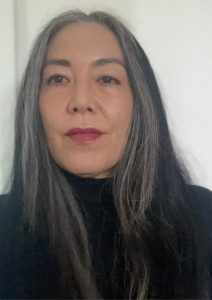
Below the Line: Congratulations on the Emmy nomination. You did some really wonderful work on Loki, and it’s nice seeing superhero shows getting awards love, especially for costumes, since they tend to go for the period stuff most of the time.
Christine Wada: Absolutely, I know, and it was a great year. I feel there were several people that were nominated, I wouldn’t have expected to be on the roster. But for us, especially as we were making it, we just really knew it was special, but we also felt like, ‘Wow, is this just gonna be too weird for everybody?’ [laughs]
BTL: You were also one of the first productions back up and running after COVID hit, so in some ways, you were true pioneers.
Wada: I know, but I think all of it ended up working in our favor in a strange way because I think we always had this very Kubrick[-like] mentality and a little bit of Terry Gilliam in our research. In a strange way, having to pivot still made it work, which I feel really lucky about. I don’t think the audience missed out on much with it because of COVID.
BTL: I previously spoke with Production Designer Kasra Farahani about the show, but before we get into Loki, I want to ask about how you first got into costume design.
Wada: I actually come from a fine art background. I wasn’t pursuing film, but fine arts is still encompassing so many aspects of costume design, in a way, that you can sort of parlay that into the same thing, because I enjoyed painting people, and I love dealing with color palettes and texture. All of that segued, really, pretty seamlessly into doing costumes.
I went to RISD [Rhode Island School of Design], and when I graduated, I moved to upstate New York for a year, and then I moved to LA, and I was trying to apply for government grants to paint public artworks. A couple of my classmates were PAs on Dragon: The Bruce Lee Story, and oddly [enough], at the time, I was really broke, and there was a scene in the 1960s in that movie. All my friends knew that I was obsessed with the ’60s and the ’70s, so they asked me to come help dress people. I just ended up doing costumes from that point on.
I’ve been doing this a really, really long time, and I had no idea that film, or costume design, could basically assemble all the different aspects of my interests. I don’t know that I would have learned that in school — I think I learned that more in the field.
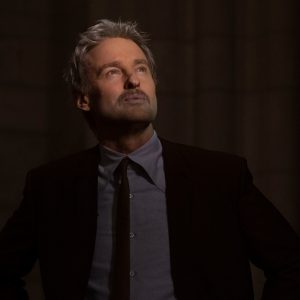
BTL: Was it easy to transition from painting or designing on the page to actually creating the physical costumes?
Wada: In a weird way, it is the same practice. If you are a costume designer, I think you could also be an interior designer. I think you could build bridges, I think you could be a flower arranger. There are so many different things you can do with that practice, and it’s not even that dissimilar to writing, because it’s just creating. You’re doing your research and your homework, and you’re creating your outline, and then you fill in your outline. I mean, that’s what you do in painting. You do studies until you figure out what you want to do, so it stays gestural and fresh when it comes out on the canvas. It’s kind of the same practice with film. I’d say it’s probably the same practice with anything creative. The university did for me, what I did not do for myself. Like, I would not have known to do it.
I think if you know how to organize your creativity, I think you can easily do so many parts. You can be a costume designer, you can be a production designer. There are so many things that you can segue that into. It’s all kind of the same brain. I’d say a costume designer does involve some bridge-building. You definitely need some engineering skills, but luckily, that is something that I enjoy. I like to take the two-dimensional to the three-dimensional. I’ve often said I should have been an engineer, and maybe I should have built bridges [laughs].
BTL: You have an incredible body of work, and yet, I may not have immediately thought of you for a superhero series, so how did you find your way to Loki, or rather, how did the show find its way to you? Did you end up having to pitch the hell out of it to the director, Kate Herron, or to Marvel?
Wada: Yeah, I did a ton of research and really let the pages of the script — I think I had three [episodes] at the time — really come to life for me through rereading, and then digging into books, and digging into even some paintings and some films, and I put this presentation together. It was sort of kismet. We all had similar references, Kasra and I did, and we didn’t know each other at that point, and Kate had done it for her pitch. It just seemed right. We all took what we read on the page and somehow all saw it the same way. It was a very special joining of minds, I’d say.
It [was] a strange transition for me, because I come from a really period background in terms of assisting or keying, and then when I broke out on my own, I did a lot of comedy, but that taught me to really run on my feet and be very quick with pivoting or coming up with ideas. I think all of that just gelled because when you come up through period costumes, you really understand construction. Since I can sketch, it brought all of my different experiences together. I’ve even done textiles for movies in the past. All of that came together and worked in my favor for doing anything that involves builds, or period and builds, or anything that is just related to the construction of costumes.
Maybe I have the added benefit of really coming from storytelling. I think Kasra comes from that, and I think Kate comes from that, and I think what made us special with this show is we always wanted our designs to feel like they had history and purpose, and that it wasn’t just topical decoration, that we really gave the audience backstory with everything that we possibly could. I feel really lucky to have been able to work with everybody from first season — Kasra, Kate, and [Cinematographer] Autumn [Durald Arkapaw]. It’s a pretty incredible group.
BTL: Kasra mentioned there was some influence from the comics that are already out there but not overly so. Was that the same for you and your department, as well?
Wada: Absolutely, absolutely. There’s a bit of influence, especially in the past, like Classic Loki or Kid Loki, but the rest is a lot from the [script] pages. The pages spoke to this Mad Men–Blade Runner world, and I think we just tried to marry that backstory with this new story of Loki. There was a lot of invention and a lot of inspiration from various sources, whether it was Bauhaus, brutalist jewelry, 1950s textiles, [or] a color palette that was, I think, incredibly original and kind of scary at the time because I remember there was a little trepidation with the choices, but I really felt married to it because I liked the way it looked with Kasra’s sets.
Also, it helped keep us out of way-future sci-fi and kept it a little grounded in that mid-century aesthetic and language, which allowed me to have a little more freedom to do some sci-fi elements without it looking unrelatable. I think that maybe our biggest achievement on this show is yes, we got inspiration from the comic books, just in that we were creating this other world, but we kept some foot in the recognizable.
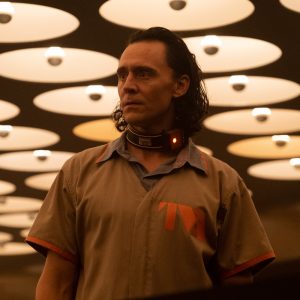
BTL: I’m glad you mentioned the color palette. How much are you taking into consideration the colors being used for Kasra’s sets when figuring out your own color palettes? It seems so critical because you could make these beautiful, colorful costumes, but they could clash with what’s going on behind them. Is there a lot of back and forth between your departments on that stuff?
Wada: A lot. A lot. Absolutely. I was constantly running over to the art department and set dec[orators] and vice versa and just checking that we were marrying up well and tried to develop things together. It involves a ton of collaboration, and, like I said earlier, I think we were very fortunate in that a lot of our references were matched up from the very beginning.
Even our guttural choices that maybe all the little details that we didn’t check on in with each other, there was such a strong visual language and outline created from the get-go that it makes choices very cohesive from all departments. The language has been set. The parameters have been set, and especially just cueing to a very iconic era, like the late ‘50s, early ‘60s, it’s such a defined era, it allows you to make choices that marry up well together between departments, even hair, say, or makeup. It allows those choices to have a better chance at marrying up. For me, that’s the first person I call when I start a job. The production designer is always the person I want to meet right away.
BTL: Let’s talk about some of the characters, beginning with Owen Wilson’s Mobius, who’s interesting, because you have the very specific costumes for the TVA, but he wears a regular suit jacket and tie, so can you talk about dressing that character?
Wada: The TVA, to me, always represented somewhat of a police station, and we worked hard at trying to create the rankings and the structure of the TVA. It seemed natural that Owen’s character would be a detective at his core and look like a detective, not a slick detective. There is always this desire to keep it somewhat Columbo-like, to give it a bit less slick and space-age as the rest of the TVA uniforms, just to give him that detective swagger, that focus. It was pretty easy to find. Once we really knew that his role was going to be that TVA detective, it just fit for him to be in the suit.
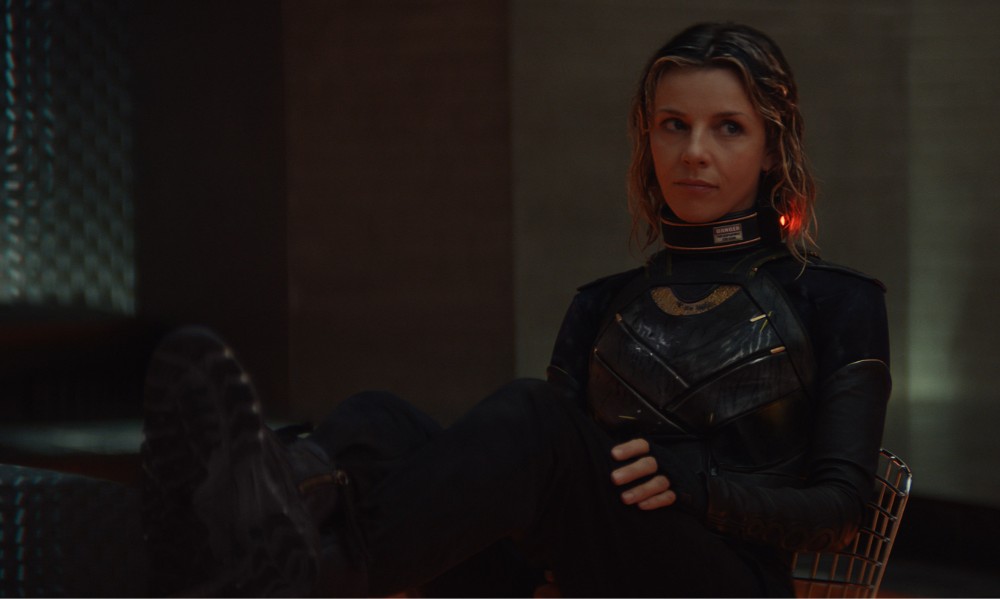
BTL: What about Sylvie? I think there’s been a female Loki in the comics, but she was very different.
Wada: Very much from scratch. It was about trying to make her look like she scavenged pieces of her wardrobe from different places and different times. She was on the run, so there was a very important and battle-worn goal for that costume. We also had to keep the costume androgynous when you first meet her character, so that there was a bit of a misdirect towards her potentially being a man. A lot of the design choices were geared towards being a little ominous, and not cueing into gender in any way. I think the whole show was also very much about that we tried very hard to be a little genderless in the show.
I don’t know if the audience picked up on it, but [we] definitely tried to get away with her not having that really overly hourglass-y, sexy superhero figure, trying to make her a bit more bad-ass androgynous. Even though she had that cloak in the beginning, once you take that cloak off her, trying to keep that armor battle-worn and not super hour-glassy. That meant she had the harem pants, which also have a very androgynous vibe and also a cross-cultural vibe, the big harem pants that seem like something that could come from any country.
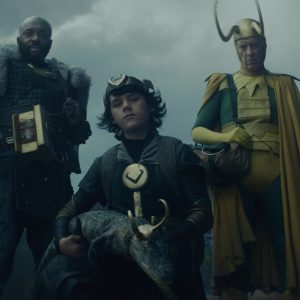
BTL: It must have been a joy to dress Richard E. Grant, who probably comes the closest to the comic book Loki that we’ve. How hard was that to bring that to reality? I’m sure when Jack Kirby designed that costume, he wasn’t thinking that there would ever be an actor having to dress up like that.
Wada: It was so fun to do that, especially because we had been in this mid-century mindset for most of the show. It just seemed that he was the mascot of the show in his sort of ’60s Batman-level of costume with old spandex and little tight booties. It was so fun to do, because, of course, the shows that you grew up on or I grew up on, watching on TNT or something. Like I said, it was almost like the mascot for the show because he really did represent the actual mid-century comic book or TV show so it was really fun to dress him. It was really a pleasure to work with an actor who can work a cape. He didn’t get the muscles but he got the cape, and boy, did he work it.
BTL: Did you end up dressing the baby crocodile Loki, or was that left up to the visual effects team?
Wada: That was fully VFX. I wish. I’ve always wanted to make an alligator costume.
BTL: People dress up their cats and dogs, so why not?
Wada: Exactly. [laughs] Halloween, get ready!
BTL: Were there any other costumes that you were particularly proud of, whether it was due to the difficulty sourcing materials or anything else?
Wada: I think one of my favorite things is that we made this entire series with all the action and Tom and Mobius wore 1960s sharkskin fabric, and there’s not an ounce of stretch in that. I think it was a marvel first that we did our main cast in non-stretch fabric. I’m still very proud of that, and I also feel very proud it was a genuine 1960s fabric; I think it’s really cool. I wish you could really see it up close, because sharkskin is usually two different colors that go between a brown and a green, which I thought was so subtle and elegant for Loki, especially because of the green. In a very subconscious way, I think it’s very special, and I think it really makes the show feel special, using fabrics that really stay true to the periods we were going after.
BTL: Did that make it harder to light the costume with the sharkskin?
Wada: No, it didn’t, but it made it harder for stunts [laughs] because everything usually has to have an element of stretch to it for all the action that happens on these shows. But we made it through. We probably went through 20 pairs of pants, but we made it through.
BTL: Are you doing Season 2 of Loki, even though Kate decided not to return?
Wada: I am. I’m in London right now doing it. Kasra and I both came back for Season 2. I’ve never done a Season 2 ever, never done it. Hopefully, we can keep the magic going.
BTL: I’m not sure if either of you even knew there was going to be a Season 2 while you were making Season 1, but I guess that’s pretty common in television.
Wada: We did not know. I think we were all surprised by it, but I think that this is the first [Marvel series] to have a Season 2.
Season 1 of Loki is now streaming on Disney+. You can also read our interviews with the show’s Emmy-nominated Production Designer Kasra Farahani and Cinematographer Autumn Durald Arkapaw, as well as Director Kate Herron.





